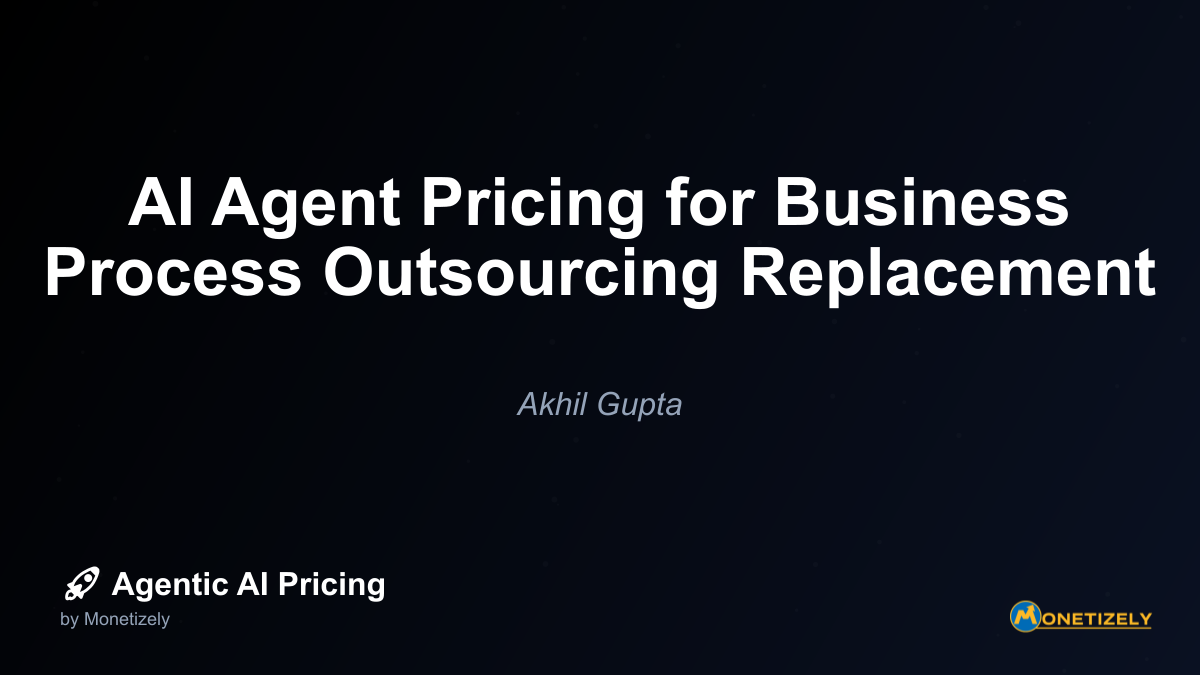· Akhil Gupta · ROI and Value · 11 min read
Key Performance Indicators for AI Success.
AI and SaaS Pricing Masterclass
Learn the art of strategic pricing directly from industry experts. Our comprehensive course provides frameworks and methodologies for optimizing your pricing strategy in the evolving AI landscape. Earn a professional certification that can be imported directly to your LinkedIn profile.

Measuring success in artificial intelligence deployments requires a structured approach to tracking outcomes. Organizations investing in AI solutions need clear indicators to demonstrate value, justify expenditures, and guide ongoing optimization efforts. While traditional business metrics remain relevant, AI implementations demand specialized performance indicators that capture both technical efficiency and business impact.
Understanding AI Performance Indicators
Performance indicators for AI systems operate on multiple levels. Technical metrics assess the underlying algorithms and models, operational metrics evaluate system behavior in production environments, and business metrics connect AI performance to organizational objectives. This multi-layered approach ensures comprehensive evaluation across the AI lifecycle.
The most effective AI measurement frameworks align with specific use cases and organizational goals rather than applying generic metrics. A customer service chatbot requires different success indicators than a predictive maintenance system or a recommendation engine. Context-specific measurement provides meaningful insights that generic frameworks cannot deliver.
Organizations often struggle with metric selection due to the complex nature of AI systems. The challenge lies in identifying indicators that balance technical performance with business outcomes while remaining accessible to non-technical stakeholders. The right metrics bridge the gap between data science teams and business leadership.
Technical Performance Indicators
Model Accuracy and Precision
Model accuracy represents the fundamental performance metric for many AI systems, measuring how often predictions match actual outcomes. However, accuracy alone provides an incomplete picture, particularly with imbalanced datasets. Precision, recall, F1 scores, and area under the curve (AUC) metrics offer more nuanced evaluation.
For classification models, confusion matrices visualize performance by showing true positives, false positives, true negatives, and false negatives. This detailed breakdown helps identify specific error types and guides model refinement. Different error types often carry varying business implications, making this granular analysis essential.
Precision = True Positives / (True Positives + False Positives)
Recall = True Positives / (True Positives + False Negatives)
F1 Score = 2 * (Precision * Recall) / (Precision + Recall)Processing Efficiency
Processing time represents a critical performance indicator for real-time AI applications. Metrics like inference time (milliseconds required to generate predictions), throughput (predictions per second), and latency (end-to-end response time) directly impact user experience and operational capacity.
Resource utilization metrics track computational efficiency through CPU/GPU usage, memory consumption, and power requirements. These indicators influence both operational costs and environmental impact. Efficient resource utilization enables more economical scaling and supports sustainability goals.
Batch processing performance becomes particularly relevant for high-volume applications. Metrics like records processed per minute and job completion time help optimize scheduling and resource allocation. These indicators support capacity planning and help identify bottlenecks in data processing pipelines.
Model Robustness
Model drift detection measures how AI performance changes over time as data patterns evolve. Monitoring prediction distribution shifts, accuracy degradation, and concept drift helps maintain reliable performance. Proactive drift detection enables timely model retraining and prevents service degradation.
Adversarial resistance evaluates model vulnerability to manipulated inputs designed to cause incorrect predictions. This security-focused metric becomes increasingly important as AI systems face sophisticated attacks. Robust models maintain performance integrity even when processing potentially malicious inputs.
Error analysis metrics identify patterns in prediction failures, revealing systematic weaknesses in model design or training data. Understanding error distribution across different input categories helps prioritize improvement efforts. Comprehensive error analysis accelerates the model refinement process.
Operational Performance Indicators
System Reliability
System uptime tracks the percentage of time AI services remain operational and available. This reliability metric directly impacts user experience and business continuity. High-stakes AI applications often require 99.9% or greater uptime guarantees.
Error rates measure the frequency of system failures, timeouts, or incorrect responses during operation. This metric helps identify stability issues and prioritize maintenance efforts. Monitoring error rates across different system components pinpoints specific reliability challenges.
Recovery time metrics evaluate how quickly systems return to normal operation after failures. Mean time to recovery (MTTR) and mean time between failures (MTBF) provide quantitative reliability benchmarks. These metrics support service level agreements and guide infrastructure investments.
Scalability Performance
Load handling capacity measures how systems perform under increasing user or transaction volumes. Stress testing reveals performance degradation patterns and capacity limits. Understanding scalability characteristics helps organizations plan for growth and peak demand periods.
Elastic scaling efficiency evaluates how effectively systems allocate and release resources in response to changing demand. Metrics like scaling response time and resource utilization during scaling events reveal operational agility. Efficient elastic scaling optimizes both performance and cost.
Cost per transaction tracks the relationship between resource consumption and business activity. This efficiency metric helps organizations optimize their infrastructure investments and identify opportunities for architectural improvements. Declining cost per transaction indicates improving operational efficiency.
Integration Effectiveness
API performance metrics assess how efficiently AI systems exchange data with other applications. Response times, error rates, and throughput for integration points reveal potential bottlenecks. Optimizing API performance improves overall system responsiveness.
Data pipeline efficiency evaluates how smoothly information flows through collection, processing, and analysis stages. Metrics like data freshness, processing time, and pipeline reliability impact AI system effectiveness. Efficient data pipelines ensure models operate with timely and complete information.
Cross-system consistency measures how well AI outputs align across different platforms and environments. This metric becomes particularly important in distributed systems with multiple deployment targets. Consistent performance across environments indicates robust implementation.
Business Impact Indicators
Productivity Enhancement
Process automation rate quantifies the percentage of tasks or decisions handled without human intervention. This metric directly measures operational efficiency gains from AI implementation. Increasing automation rates typically correlate with productivity improvements and cost savings.
Time savings calculations compare process completion times before and after AI implementation. These measurements reveal productivity enhancements in concrete, quantifiable terms. Time savings metrics resonate particularly well with operational stakeholders and frontline employees.
Output volume metrics track production capacity improvements enabled by AI systems. Increased throughput without corresponding resource expansion demonstrates clear efficiency gains. Volume metrics help justify AI investments through direct operational impact.
Quality Improvements
Error reduction rates measure how AI implementation affects mistake frequency in business processes. Comparing error rates before and after deployment quantifies quality improvements. These metrics often reveal benefits beyond simple efficiency gains.
Consistency scores evaluate how uniformly processes perform across different conditions, times, and operators. AI systems typically improve consistency by standardizing decision-making. Higher consistency scores indicate more reliable operations and predictable outcomes.
Compliance adherence metrics assess how effectively systems meet regulatory and policy requirements. AI can enhance compliance through consistent rule application and comprehensive documentation. Improved compliance metrics reduce organizational risk and potential penalties.
Financial Performance
Cost reduction metrics directly measure expense decreases attributable to AI implementation. Categories include labor costs, error-related expenses, and operational overhead. These concrete financial benefits provide clear return on investment evidence.
Revenue enhancement tracking identifies additional income generated through AI-enabled capabilities. Sources include new product offerings, increased sales conversion, and improved customer retention. Revenue metrics complement cost savings in the overall financial impact assessment.
Return on investment calculations combine implementation costs, ongoing expenses, and financial benefits into comprehensive evaluation metrics. ROI analysis typically includes both direct financial returns and risk-adjusted projections. Sophisticated ROI models incorporate both tangible and intangible benefits.
ROI = (Financial Benefits - Implementation and Operating Costs) / (Implementation and Operating Costs)Customer Experience Indicators
Satisfaction Metrics
Customer satisfaction scores directly measure user sentiment toward AI-enabled services. Metrics like Net Promoter Score (NPS), Customer Satisfaction Score (CSAT), and Customer Effort Score (CES) quantify experience quality. Improving satisfaction scores indicate successful user-facing AI implementation.
Engagement metrics track how users interact with AI systems through metrics like usage frequency, session duration, and feature adoption. Strong engagement suggests the AI delivers meaningful value to users. Declining engagement often signals experience problems requiring attention.
Retention and churn metrics measure how AI implementation affects customer loyalty and longevity. Improved retention rates directly impact business value through extended customer lifetime value. These metrics provide lagging indicators of overall experience quality.
Interaction Quality
Response accuracy tracks how correctly AI systems address user inquiries or requests. This metric applies particularly to conversational AI and recommendation systems. High accuracy rates correlate with user trust and system adoption.
Resolution speed measures how quickly AI systems provide satisfactory answers or solutions. First-contact resolution rates are especially important in customer service applications. Faster resolution improves user experience while reducing operational costs.
Personalization effectiveness evaluates how well AI systems tailor interactions to individual user needs and preferences. Metrics include recommendation relevance, content customization accuracy, and adaptive interaction appropriateness. Effective personalization enhances engagement and satisfaction.
Feedback Analysis
Sentiment tracking analyzes user feedback to identify emotional responses to AI interactions. Natural language processing techniques quantify positive, negative, and neutral sentiment trends. Sentiment analysis provides early warning of experience issues before they affect behavior metrics.
Feature request patterns reveal user priorities and unmet needs through analysis of enhancement suggestions. This qualitative feedback complements quantitative performance metrics. Understanding feature requests helps guide development priorities and improvement efforts.
Complaint frequency and categories track negative feedback patterns to identify specific improvement opportunities. Declining complaint volumes indicate experience improvements, while changing complaint categories reveal evolving user priorities. Complaint analysis drives targeted enhancement efforts.
Implementation Success Indicators
Adoption Metrics
User adoption rates measure how quickly and completely target audiences incorporate AI tools into their workflows. Metrics include percentage of eligible users, frequency of use, and feature utilization depth. Strong adoption indicates perceived value and effective change management.
Training effectiveness evaluates how well users understand and utilize AI capabilities through knowledge assessments and behavior observation. Effective training accelerates adoption and maximizes value realization. Training metrics help optimize onboarding and ongoing education efforts.
Workflow integration success measures how seamlessly AI capabilities incorporate into existing business processes. Metrics include process exceptions, manual overrides, and transition friction points. Smooth integration supports both adoption and productivity benefits.
Development Efficiency
Development cycle metrics track the efficiency of AI solution creation and enhancement through timeframes like concept-to-deployment duration and iteration frequency. Efficient development processes enable faster value realization and more responsive enhancement.
Resource utilization during development measures how effectively organizations deploy talent, computing resources, and financial investments in AI creation. Efficiency metrics help optimize development economics and maximize return on technology investments.
Technical debt accumulation tracks implementation compromises that may require future remediation. Monitoring technical debt helps balance delivery speed with long-term sustainability. Managing technical debt appropriately supports both agility and system longevity.
Governance Effectiveness
Policy compliance metrics evaluate how well AI implementations adhere to organizational and regulatory requirements. Areas include data privacy, security standards, and ethical guidelines. Strong compliance metrics reduce organizational risk and support responsible AI deployment.
Documentation completeness measures how thoroughly teams record design decisions, data sources, model characteristics, and operational procedures. Comprehensive documentation supports maintenance, knowledge transfer, and regulatory compliance. Documentation metrics encourage sustainable implementation practices.
Audit readiness assesses how prepared organizations are for internal or external AI system reviews. Metrics include documentation accessibility, traceability of decisions, and explainability of outcomes. Audit readiness supports both operational continuity and regulatory compliance.
Creating an Effective AI Measurement Framework
Aligning Metrics with Objectives
Business goal mapping connects performance indicators to specific organizational objectives. This alignment ensures metrics drive meaningful outcomes rather than technical achievements alone. Effective mapping requires collaboration between technical and business stakeholders.
Stakeholder-specific dashboards provide tailored views of AI performance based on different roles and priorities. Executive dashboards emphasize business impact, while technical dashboards highlight system performance. Role-appropriate metrics improve decision-making across the organization.
Value chain integration positions AI metrics within broader business process measurements. This contextual approach shows how AI performance affects upstream and downstream activities. Integrated measurement reveals systemic impacts beyond immediate application areas.
Implementation Considerations
Measurement infrastructure requirements include data collection mechanisms, analysis tools, and reporting systems. Effective measurement requires appropriate technical foundation. Infrastructure planning should occur during initial AI implementation rather than as an afterthought.
Baseline establishment creates reference points for performance comparison through pre-implementation measurement and industry benchmarking. Meaningful improvement assessment requires clear baselines. Baseline data collection should begin before implementation whenever possible.
Continuous improvement processes establish regular review cycles, action planning protocols, and accountability mechanisms. Structured improvement approaches transform measurement insights into concrete enhancements. Effective processes close the loop between measurement and action.
Common Pitfalls to Avoid
Vanity metrics focus on impressive-sounding numbers without meaningful business impact. Examples include raw model accuracy without context or user counts without engagement quality. Avoiding vanity metrics requires discipline and business outcome focus.
Measurement overhead occurs when data collection and analysis consume excessive resources relative to their value. Efficient measurement focuses on high-impact indicators rather than exhaustive tracking. Streamlined approaches prevent measurement from becoming burdensome.
Context neglect happens when metrics ignore important situational factors affecting performance interpretation. Contextual factors include seasonal patterns, market changes, and organizational transitions. Effective measurement incorporates relevant context for accurate assessment.
Conclusion
Effective AI performance measurement combines technical, operational, and business metrics to create a comprehensive view of implementation success. Organizations should select indicators aligned with their specific use cases and strategic objectives rather than applying generic frameworks. The most valuable measurement approaches evolve over time as AI capabilities mature and business needs change.
Successful measurement practices share several common characteristics: they connect technical performance to business outcomes, provide appropriate metrics for different stakeholders, establish clear baselines for comparison, and integrate with continuous improvement processes. These principles apply across AI applications from machine learning models to natural language processing systems.
Organizations beginning their AI measurement journey should start with a focused set of high-impact indicators rather than attempting comprehensive tracking immediately. As measurement capabilities mature, metrics can expand to cover additional performance dimensions. This incremental approach delivers immediate value while building toward more sophisticated measurement over time.
Co-Founder & COO
Akhil is an Engineering leader with over 16+ years of experience in building, managing and scaling web-scale, high throughput enterprise applications and teams. He has worked with and led technology teams at FabAlley, BuildSupply and Healthians. He is a graduate from Delhi College of Engineering and UC Berkeley certified CTO.
Pricing Strategy Audit
Let our experts analyze your current pricing strategy and identify opportunities for improvement. Our data-driven assessment will help you unlock untapped revenue potential and optimize your AI pricing approach.




